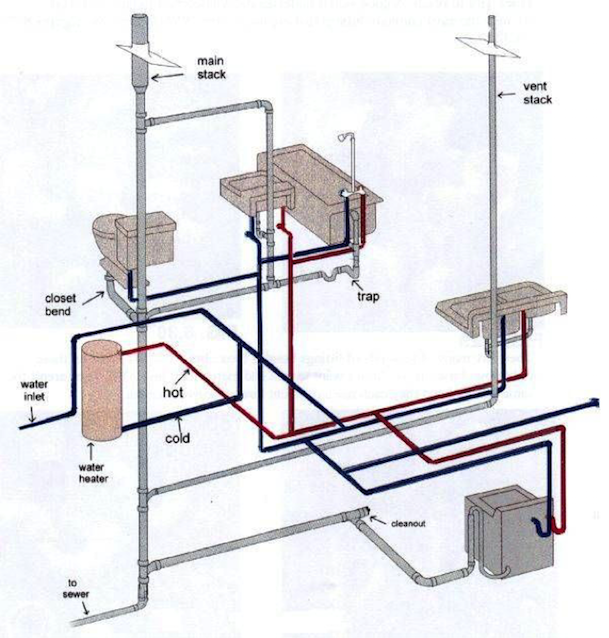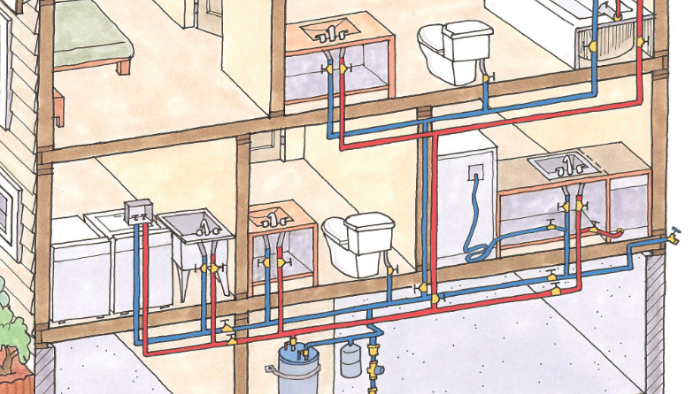Have you been on the lookout for content about Understanding Your Home's Plumbing Anatomy?

Recognizing how your home's plumbing system functions is essential for every homeowner. From supplying tidy water for drinking, food preparation, and showering to securely eliminating wastewater, a well-kept plumbing system is important for your household's health and wellness and comfort. In this comprehensive overview, we'll discover the complex network that makes up your home's plumbing and deal ideas on upkeep, upgrades, and dealing with common concerns.
Intro
Your home's plumbing system is greater than just a network of pipelines; it's an intricate system that guarantees you have accessibility to clean water and efficient wastewater elimination. Understanding its components and how they work together can aid you stop costly repairs and make certain whatever runs smoothly.
Basic Elements of a Plumbing System
Pipelines and Tubes
At the heart of your plumbing system are the pipelines and tubes that carry water throughout your home. These can be constructed from numerous products such as copper, PVC, or PEX, each with its benefits in terms of durability and cost-effectiveness.
Fixtures: Sinks, Toilets, Showers, etc.
Components like sinks, toilets, showers, and bath tubs are where water is utilized in your home. Comprehending how these components connect to the plumbing system aids in identifying troubles and planning upgrades.
Valves and Shut-off Factors
Valves manage the circulation of water in your plumbing system. Shut-off shutoffs are vital throughout emergencies or when you require to make repair work, permitting you to separate parts of the system without interrupting water flow to the entire residence.
Water System
Key Water Line
The major water line links your home to the local water or a private well. It's where water enters your home and is distributed to different components.
Water Meter and Pressure Regulator
The water meter procedures your water usage, while a pressure regulatory authority ensures that water streams at a risk-free stress throughout your home's pipes system, preventing damages to pipelines and components.
Cold Water vs. Warm water Lines
Understanding the difference between cold water lines, which provide water directly from the major, and warm water lines, which lug heated water from the water heater, assists in fixing and preparing for upgrades.
Water drainage System
Drain Pipeline and Traps
Drain pipes carry wastewater away from sinks, showers, and bathrooms to the drain or septic system. Catches prevent sewer gases from entering your home and additionally catch particles that can cause clogs.
Ventilation Pipes
Air flow pipelines permit air into the drainage system, avoiding suction that might slow down water drainage and cause traps to empty. Appropriate ventilation is necessary for keeping the honesty of your plumbing system.
Significance of Appropriate Drain
Making sure correct water drainage protects against backups and water damage. Routinely cleaning drains and maintaining traps can prevent expensive repair work and prolong the life of your plumbing system.
Water Heating System
Types of Water Heaters
Hot water heater can be tankless or traditional tank-style. Tankless heaters warmth water as needed, while containers keep heated water for immediate usage.
Just How Water Heaters Attach to the Pipes System
Comprehending how water heaters attach to both the cold water supply and warm water distribution lines helps in detecting problems like insufficient warm water or leaks.
Upkeep Tips for Water Heaters
Frequently flushing your hot water heater to remove debris, inspecting the temperature settings, and checking for leaks can prolong its lifespan and boost energy performance.
Typical Pipes Issues
Leakages and Their Causes
Leakages can occur as a result of aging pipes, loosened fittings, or high water stress. Dealing with leakages quickly protects against water damage and mold and mildew growth.
Clogs and Clogs
Blockages in drains pipes and bathrooms are typically caused by flushing non-flushable things or an accumulation of grease and hair. Making use of drain displays and bearing in mind what goes down your drains pipes can avoid obstructions.
Indications of Pipes Troubles to Look For
Low tide stress, slow drains pipes, foul odors, or unusually high water expenses are indications of potential pipes problems that must be addressed without delay.
Plumbing Maintenance Tips
Routine Inspections and Checks
Arrange yearly plumbing examinations to catch concerns early. Try to find signs of leakages, corrosion, or mineral build-up in faucets and showerheads.
Do It Yourself Upkeep Tasks
Basic jobs like cleaning faucet aerators, checking for bathroom leakages making use of dye tablet computers, or insulating subjected pipes in chilly environments can prevent major plumbing problems.
When to Call a Professional Plumbing Professional
Know when a pipes issue requires professional experience. Trying complex repairs without proper expertise can bring about more damages and greater repair work prices.
Upgrading Your Plumbing System
Reasons for Upgrading
Updating to water-efficient components or changing old pipelines can improve water high quality, minimize water costs, and raise the worth of your home.
Modern Plumbing Technologies and Their Benefits
Check out modern technologies like clever leakage detectors, water-saving commodes, and energy-efficient hot water heater that can conserve cash and minimize environmental impact.
Cost Considerations and ROI
Calculate the upfront prices versus lasting cost savings when thinking about plumbing upgrades. Many upgrades spend for themselves via minimized energy expenses and less repair services.
Ecological Effect and Preservation
Water-Saving Components and Home Appliances
Installing low-flow faucets, showerheads, and toilets can considerably decrease water usage without sacrificing efficiency.
Tips for Decreasing Water Usage
Basic routines like taking care of leakages quickly, taking shorter showers, and running complete tons of laundry and dishes can preserve water and reduced your utility bills.
Eco-Friendly Pipes Options
Take into consideration lasting pipes materials like bamboo for flooring, which is durable and eco-friendly, or recycled glass for kitchen counters.
Emergency situation Readiness
Steps to Take During a Pipes Emergency situation
Know where your shut-off valves are located and just how to switch off the water system in case of a burst pipe or significant leak.
Importance of Having Emergency Situation Get In Touches With Handy
Maintain get in touch with information for neighborhood plumbing professionals or emergency services readily offered for quick feedback throughout a plumbing situation.
DIY Emergency Fixes (When Relevant).
Momentary fixes like making use of duct tape to spot a leaking pipeline or positioning a bucket under a leaking tap can decrease damage up until a professional plumbing technician arrives.
Verdict.
Comprehending the makeup of your home's pipes system empowers you to keep it efficiently, conserving time and money on repair work. By adhering to regular maintenance regimens and staying educated concerning modern plumbing modern technologies, you can guarantee your plumbing system operates efficiently for many years to find.
HOW YOUR PLUMBING SYSTEM WORKS
Which Pipes Do What?
Blue lines = fresh water supply entering the building Red lines = hot water supply entering the building Grey lines = pipes carrying waste away from the building and venting pipes carrying gases away from the building (through the roof) YOUR MAIN PLUMBING SYSTEMS
There are two main plumbing systems that support your home s basic plumbing needs one that brings clean water into your home, and one that sends dirty water away from your home. Connected to the toilet, bath, shower, and other faucets in your home, these two systems keep your water flowing in the right directions.
ACCESSING FRESH WATER
Fresh and clean water is brought into your home through the main water supply line . Filtered through one pipe, this water is pressured to flow into the various fixtures in your home at any given time.
This water can be sourced from a well located on your property, a pond or river (mostly cottages), or, as in most cases, from the city s municipal water treatment centre. However, it is important to note that water that is untreated, such as the water siphoned from ponds or rivers, may not be safe to drink. Personal water supplies always need to be treated for hardness and contaminants before consumed.
MUNICIPAL WATER SUPPLIES
Improve taste and odour Remove sediment Eliminate hardness Reduce chlorine COLD WATER SUPPLY VS. HOT WATER SUPPLY
Cold water flows into your home or building through the service line, which then distributes hot or cold water to your fixtures. This line is most commonly run through a central column that runs floor to floor. Hot water runs in short and straight pipes as the longer the pipeline, the more heat that will be lost in the transfer. Having shorter pipes also allows residents to access hot water more quickly.
WASTE WATER SYSTEM
Your wastewater system is divided into two parts pipes that send wastewater away from your home and venting pipes that send sewer gas away from your home. Sewage water travels through pipes that flush the water and waste towards local sewers that are operated and managed by your city or town. Most sewer systems rely on gravity to move the wastewater to where it needs to go.
The further away from your toilet or sink, the larger wastewater pipes become. This allows for waste to be disposed of from various parts of your home or business at once without pipe blockages. The angle and flow of these pipes are also essential for keeping your waste pipes clear of build up.
https://harrisplumbing.ca/how-your-home-plumbing-system-works/

Do you appreciate more info about Anatomy of a House: Understanding the Components? Try to leave a remark further down. We would be delighted to know your responses about this posting. In hopes that you come back again in the near future. In case you liked our blog entry please be sure to share it. Thanks for your time spent reading it.
Browse Website